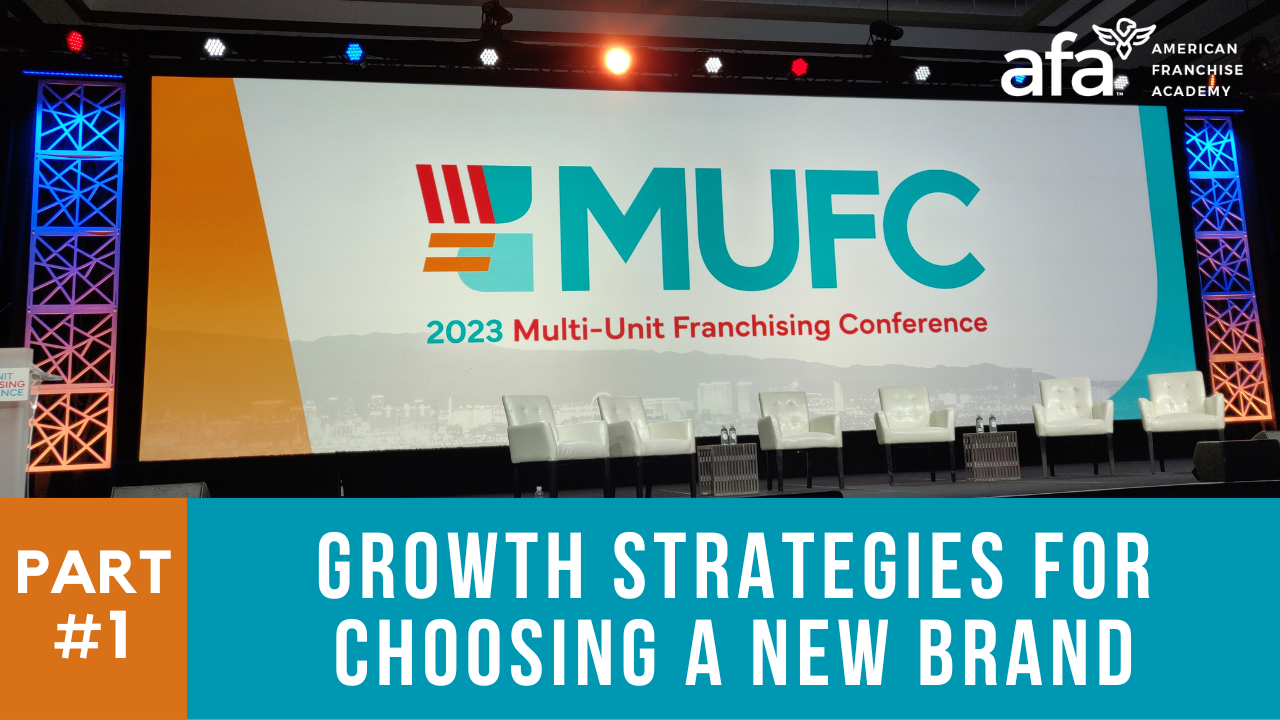11 Growth Strategies for Choosing a New Brand

(Part 1 of the Multi-Unit Franchising Conference 2023)
Every year, The American Franchise Academy, and myself, participate in the Multi-Unit Franchising Conference, an event that focused on the development, growth, and support of franchisees that are multi-unit or that want to grow their organization with either more units or more brands.
- In the following weeks, I’ll share the content of some of the sessions that I participated in, around knowledge, best practices, and valuable information for the franchisees’ success.
To kick off this series, I’ll start with one of the best sessions of the whole conference, a panel called “Growth Strategies for Choosing a New Brand”, with four very experienced, very knowledgeable, multi-unit multi-brand leaders:
- Gary Robin, a multi-unit multi-brand franchisee from Supercuts and Ideal Image.
- Robert Branca, the largest Dunkin’ Donuts franchisee with more than 200 units. He also owns other private businesses.
- Shamsu Charania, a multi-brand franchisee from Baskin-Robbins, Checkers&Rally’s, Dunkin’ Donuts, and TGI Fridays.
- Aziz Hashim, leader of NRD Capital, with brands like Altitude, Trampoline parks, Frisch’s Big Boy, Fuzzy’s Taco Shop, and The Captain’s Boil, among others. He also has investments in technology that support the franchise industry.
The following are their recommendations of the things you should consider as you're going through the process of defining what your next brand is going to be. This content is valuable for aspiring franchisees looking for their first brand or franchisees wanting to grow into a second brand.
Still wondering? These are the pros & cons of becoming a multi-unit franchisee
1. Unit Economics
Something the panel agreed upon is that the number one requirement you should look for in a franchise brand is that they have healthy and positive unit economics.
You have to remember that you invest in a franchise to make money. And so, you need to understand what is the unit economics of that particular brand, from the perspective of what is the average bottom line for these brands.
Beware: some franchisors tend to show only the scope of how their top-performing units behave but you wouldn’t get the whole picture if you only see that 20%.
Don’t miss: The importance of developing strong financial acumen
2. Emerging brands
Another thing they pointed out is that sometimes you can make more money out of smaller emerging brands than of mature and legacy brands. This is because a lot of these big brands come with a hefty cost package you have to invest in every month, whereas emerging brands may give you a healthy bottom-line profit.
These emerging brands were a topic that several of them discussed during the session because there are about 300 new emerging brands in the franchise industry. There are a lot of start-up selling franchises every year to choose from, in all kinds of industries and business models.
If these brands have a great product, an unforgivable service, and offer outstanding customer experience, which you can measure through Google reviews, this could be a potentially good investment for you.
Don't discount emerging brands because they're newer. But if you opt for one, really look into what is their business model, what is the customer experience like, what is the product, and analyze if these are good options for you.
3. Market segment analysis
You also need to analyze what is the market segmentation of that particular brand and whether it has a favorable perspective or not. You can do this analysis by answering questions like “Is this product or service consumed every day or at least more than once a week?”
If it does, then the likelihood of it being a successful long-term brand will be higher. On the other hand, if there is less frequency, then you’ll need a higher ticket item.
Let’s say you want to franchise a car service. If the brand sells tires that cost $500, it’ll have a much higher ticket. Although consumers don't need tires every week, the model works because the low frequency is compensated with a higher ticket.
So if it's something that consumers buy every day, then having a lower ticket will be normal. But if it's used less often, then the franchise needs to have a higher ticket to maintain a profitable, successful business in the long term.
You also have to ask yourself:
- How many businesses are there in this market, regarding chains, brands, franchisors, and even independent businesses that might compete in this space?
- Can this brand compete and be above the rest to have a healthy business?
4. Franchise Disclosure Document (FDD)
When choosing a brand you have to look at the FDD, the Franchise Disclosure Document, as well as the franchise agreement.
Usually, when you are interested in a brand and complete the application process, you receive the FDD, where you can go through a lot of the brand’s information. If you move forward, eventually you get a copy of the franchise agreement, where you'll be able to research in great detail what comes in and what doesn't come with this particular franchise brand.
You must read everything in these documents! I know they are enormous and difficult language to understand, but a franchise lawyer can be of much help to interpret and explain what you will be agreeing to if you invest in that franchise. This is crucial for your success in choosing the right brand for you.
Don’t miss: Choose the best franchise! 6 tips to find your perfect match
As you read these documents, keep in mind that they are designed to protect the brand, not their franchisees. Also, don’t be surprised if you don’t find much about what the franchisor delivers to the franchisee since these documents focus more on what the franchisee must follow when it comes to the franchisor’s brand.
Yet, there are some brands that, when needed, go above and beyond the FDD and the franchise agreement. When Covid happened, certain brands stepped up to the plate to support their franchisees, showing they were truly committed to their success.
Covid impacted the franchisee-franchisor relationship. One of those things that changed was that if you close units as a result of something you can’t control, there are no longer punitive damages because of it, in many situations.
Another thing that changed is spousal or personal guarantees in the franchise agreement. Before Covid, there were a lot of requirements when it came to personal guarantees but now, a lot of franchise owners are more flexible in that area. And
As you go through the process of analyzing the brands you're interested in, research carefully, and if these clauses are still there, see if you could negotiate to take them out.
A good way to broaden your due diligence to choose a new brand is to have many healthy, deep discussions and conversations with existing franchisees. Don’t underestimate this strategy; they will share things with you that you would not see in the FDD or the franchise agreement!
5. The brand culture
Founders are no longer in charge of many brands. Perhaps those original, excited, and passionate entrepreneurs, who committed to the brand’s growth, decided to sell to another company, an equity firm, or their relatives are now leading the operations.
When you deal with a brand in which the franchise owner is still the founder, there might be a little bit more flexibility and more relationship-based decisions rather than legal agreements. But when other people get involved in the decision-making, things change.
Who the leaders are as far as their personality and the franchise’s culture, will dictate how much you’ll be able to negotiate certain agreements. That’s why you have to be clear on what is the current culture of the brand, as well as who’s leading the organization and who owns the brand.
One of the panelists advised that before you enter any agreement, you need to look very closely at three things:
- Unit economics, which is something I already mentioned. You can go deeper and ask existing and former franchisees to verify what the financials may or may not look like, so you have the most accurate information possible.
- An exit strategy, because nobody gets into business to be in business forever. You either enter so you can then pass it on to your family members, or eventually sell and retire. Revise if the brand facilitates that exit strategy.
- The necessary remodel or technology investment if a transfer happens. Sometimes there are acquisitions and you may end up with a huge remodel or technology investment that you did not count on when you made the price offer for this brand, especially when you negotiate a large number of units. This is very important because it could mean a very costly mistake.
6. Issues when transferring a franchise business
Speaking of exits, when selling or acquiring a business you have to be aware of what will change in the agreement when that transfer happens. Sometimes franchisees have benefits such as a reduction in royalty costs or favorable franchise fees. But there could also be tougher agreements, perhaps higher royalty fees or more requirements within these new agreements.
When you're looking at somebody's package, you need to understand what terms they are operating under, how would that change if you acquire, and what are the rules that franchisors are putting down. For example, they are now blocking private equity investment in franchise brands. They are also putting a lot of remodeling requirements.
You must also know what the franchisor will allow you to do and not to do. Some brands are not very friendly with transferring businesses, others won’t agree with you forming a trust to inherit your franchise to your family members.
So the recommendation of this very experienced panel is to have a great accountant and CPA to analyze the numbers and do proper business projections, but also to have great legal support with experienced and knowledgeable people in franchising and franchising law to look for the things that could hurt you.
Another recommendation is to reach out to a franchise association. This group of franchisees will give you valuable information that can help you decide which brand you should invest in.
7. Price
- How much should you pay for the new franchises, whether you want to acquire an existing brand or you want to do a build-out?
According to this panel of multi-unit leaders, franchise investors tend t do an evaluation assessment mistake of a unit. What that means is that you need to understand the cost of buying an acquired unit vs. the cost of building a unit.
Imagine that the multiple of a particular brand is five times and you have an EBITDA of, say, $200,000. So 200 x 5 = $1,000,000, meaning that this particular unit will cost you $1 million. A build-out, on the other hand, will cost you $1.2 million. So your franchise investment goes above and beyond what you pay to acquire an existing unit.
Not only that. You might spend all that money and not make as much profit as you would when acquiring a unit that is already cash-flowing and has $200,000 in EBIDTA. In that case, acquiring an existing unit might make more sense than building one.
Or it could be the opposite. Perhaps the building of a unit is 20% less costly and, even if it was not as high volume or as financially viable as the other one, it will still be much more profitable at the end of the day because the cost will be less. That’s why you must know how to calculate and understand this information so that you can make the best decision for you and your organization.
Don’t let cost control paralyze your success! Make the most of your investment with these tips
8. The overall brand’s health
This concept focuses on the management and ownership of the brand. To discover the true state you must know aspects like:
- Who is the franchisor or who owns the brand?
- What is their balance sheet?
- How much are the capitals and how much debt do they have?
- What is their liquidity?
- Do they have enough cash to continue to operate the brand at a high level?
- Are the owners focused on profitability and turnaround or are they willing to invest in people, technology, and innovation?
- Is there a risk that valuable, experienced, and knowledgeable executives and team members may end up going to the competition?
Another factor that highlights the health of the franchise is if the company runs units of its own. There is great value in having the franchisors operate some stores, not just for testing purposes, but for understanding what the franchisees are going through in their business.
- Think about it! If the franchisor considers that their business is good and healthy enough to have their own company units, and they operate them successfully, that means that it should be a good business.
9. Large deals
One particular panelist advise not to sign too large deals (anything over 30 or 40 units), especially if it involves a high ticket upfront, because your financials can get hurt if you make a mistake. And, if you do want a large deal, the recommendation is to make sure there’s a payment plan or a long-term thing.
Another piece of advice on this matter is not to sign anything beyond four or five years. The panel mentioned how they focus on 2-3 year deals, and between 15-20 units at a time.
By doing that, they protect themselves from making mistakes because those are not easy to correct. They might still make some, but at least they're not so catastrophic for their overall business.
10. Underwriting of franchisees
If you have a good financial history and you choose a brand that is seen in a positive way among financial institutions, you shouldn’t have a problem accessing capital at a favorable cost.
Usually, if the franchisor has a good business model and a positive record of choosing great franchisees that deliver good results and who keep their responsibilities, you will have access to capital. But, if the institutions don’t see the brand with positive eyes, consider it a red flag.
11. Franchisee engagement
The last thing these leaders talked about is looking at franchise associations that are truly active in collaboration with the franchisors so that it makes it a win-win for everybody. This also talks volumes about the culture and the management of the organization.
Another thing to look at is it the association has an elected advisory council, or a franchise body that represents them in front of the franchisor. That means that these people dedicate time and effort to build that relationship for the benefit of both franchisees and the franchise organizations.
On a closing note, Aziz Hashim shared how if you have a great brand, there is usually a great association behind it, that’s collaborating with the franchisor in a way that everybody wins.
I know this has been a longer blog post than usual, but I think every piece of it has very valuable information for aspiring franchisees and experienced ones that want to grow multi-unit or multi-brand.
I hope you got some ideas and best practices you can implement when you consider buying or acquiring additional units or maybe a second brand. A lot of these tips are right on, and if you take the time and the discipline to go through the due diligence process, I’m sure you will make the best decision for you!
Don't forget to follow us on our YouTube channel, subscribe to our podcast and find us on all of our platforms across social media, where you can find a lot more knowledge, tips, and information for you to be successful.
Reflections:
- Are you including your areas of opportunity as part of your due diligence process?
- What’s the current landscape of your G&A? How do you anticipate this will look as you begin your plans to grow with a new brand?
- Is your current team agile and resilient? How can you prepare them for a new brand?
- Does the franchise you are interested in match your culture, values, and franchisee profitability?
WATCH THIS VBLOG on YouTube HERE.



